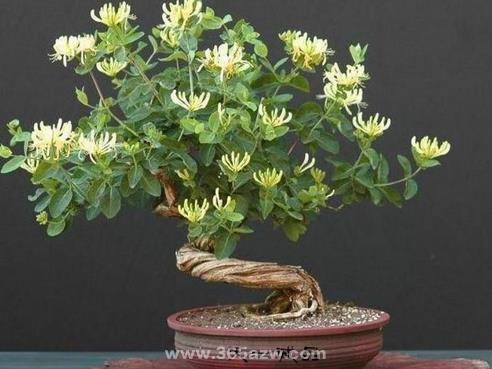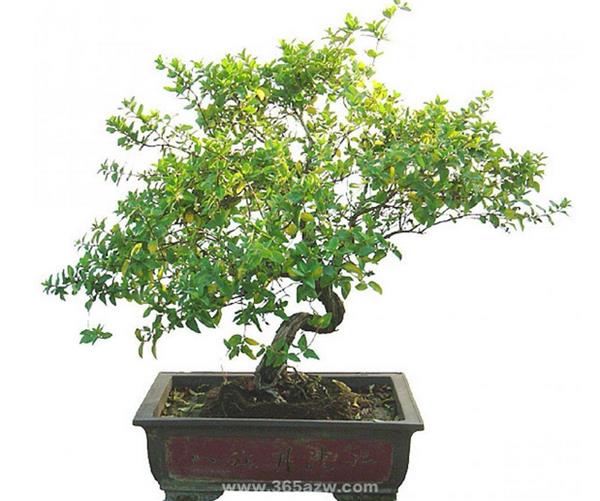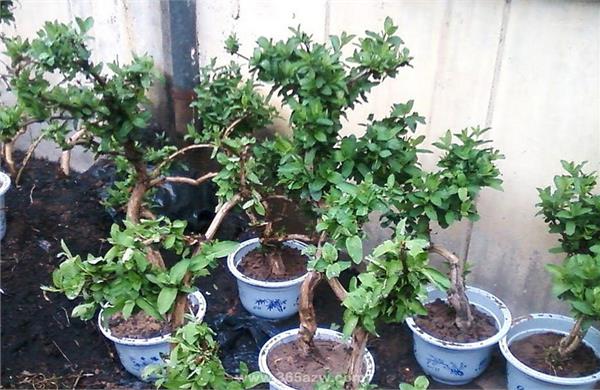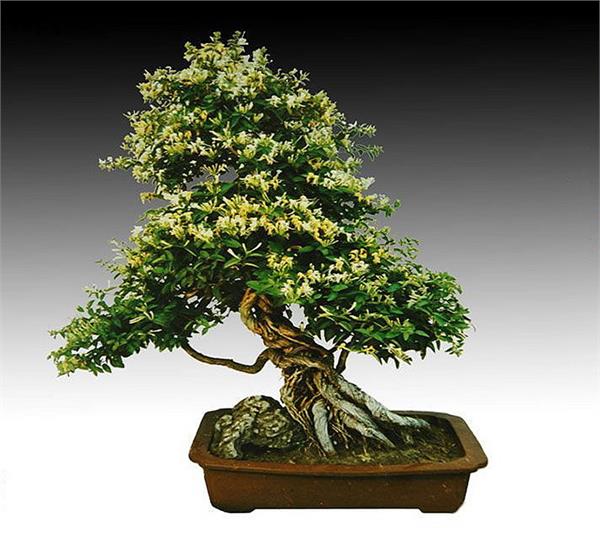Detailed introduction of culture and maintenance methods of honeysuckle bonsai
Honeysuckle has been known as a good medicine for heat-clearing and detoxification since ancient times. It is sweet and cold fragrant, sweet cold and clear heat without harming the stomach. Let's take a look at the details of the breeding and maintenance methods of honeysuckle bonsai.

Detailed introduction of culture and maintenance methods of honeysuckle bonsai
Culture method of potted Flos Lonicerae
1. Moisture
Usually, we should insist that the basin soil has enough water, especially during the flowering period. If the soil is too dry, it will affect the growth and flowering.
Although the management of cultivated honeysuckle is extensive, watering should still be "wet and dry", that is, it should be watered until the basin bottom is out of water, and then when the basin soil has been dehydrated and dry.
It is best to use river water; Rain Water or ditch and pond water; urban tap water contains more chlorine, which can be stored and dried in advance and can be used after chlorine is completely volatilized. The water temperature of watering flowers in winter should be close to room temperature. The amount of water is the most in summer, the second in spring and autumn, and the least in winter.
The flowering period should be watered as little as possible, which can prolong the flowering period.
2. Soil
The preparation of soil for cultivation is the key. Cultivated soil should be rich in nutrition, loose and strong water retention capacity as the standard, preferably acidic or slightly acidic soil.
Generally, the mixture of river sand and pine needle rotten leaf soil can be used as culture soil, which can be divided into coarse, medium and fine culture soil after sieving.

When getting on the soil, we should first cover the basin bottom water hole with two pieces of broken tiles, then put the thicker culture soil on the bottom, and put the rotten manure as the long-term fertilizer; then cover the fertilizer with medium-grain culture soil, and then plant it, and finally cover it with fine-grained culture soil.
The soil in the new basin is very loose, so you can press it gently with your hands, and then slowly water it to prevent the topsoil from being washed into a big pit. After the first full infiltration, it needs to be irrigated again until a small amount of water flows out of the basin bottom hole.
3. Pruning
Shaping and pruning is the main processing method of potted honeysuckle.
Because of the strong germination of honeysuckle, it is suitable for a variety of bonsai modeling.
Honeysuckle should be pruned in time during dormancy.
During pruning, only one trunk with high 10~20cm was left, 3-5 main branches were left on the trunk, and 3-5 lateral branches were left on each main branch, so that the whole plant showed "flowering type". After the beginning of spring, all the buds on the trunk are removed, and the top of the main branch is removed before flowering, so as to promote the plant to send more flower branches.
After flowering, re-pruning should be carried out to truncate the upper part of the flowering branches, leaving only 3-5 nodes, and cut off some new branches and weak branches according to the specific conditions.
Through pruning, the stem and branches of the whole plant type are coordinated and distinct.
4. Fertilizer
Honeysuckle blossoms in early summer, it is best to apply "flower bud fertilizer" before and after the Spring Equinox. When the flower buds are covered with branches, apply phosphate fertilizer again. After the first round of flowers are in full bloom, it is still necessary to apply light organic liquid fertilizer. And cut off the near-withered bouquet, reduce nutrition consumption, in order to promote sustainable flowering. Honeysuckle can also apply "bud-promoting fertilizer" in Greater Cold and "root-promoting fertilizer" in the Beginning of Spring.

Honeysuckle germination is very strong, pruning is very important. Cut off the thin branches and all kinds of branches that affect the posture during the dormant period, and cut the strong branches properly. After the first flowering, coring can promote the second flowering of honeysuckle. After pruning, the sprouting shoots are mostly flower branches, which can blossom when they grow to 10-20 cm.
Maintenance methods of potted Flos Lonicerae
I. selection of pile head of Honeysuckle
Although honeysuckle has all kinds of pile heads in nature, there are not many suitable for making bonsai, so we should try to choose stumpy roots, stout, vigorous and simple, curved changes, short and compact tree shapes, thick and short internodes, and natural tree stumps.
By cultivating bonsai of honeysuckle, the seedlings of short and easy flowering internodes can also be planted in places with deep, loose and fertile soil and rapid growth. When the ideal roughness is reached, it can be cultivated in the basin. In this way, you can not only watch and pick flowers, but also get a more ideal honeysuckle pile head, killing many birds with one stone.
II. Cultivation and management
Bonsai of honeysuckle can be planted all the year round, especially in late autumn and early winter. In order to make the bonsai of honeysuckle grow well, the living honeysuckle can be planted in an ornamental basin suitable for the size of the pile in late autumn and early winter, and then cultivated with prepared fertile humic loam, covered with green moss, and then watered to facilitate survival. Due to the limitation of cultivation containers, honeysuckle bonsai often need to replenish water and nutrients. Especially in the growing season, fertilization should be based on phosphorus and potassium fertilizer, and rotten cake fertilizer should be applied once a week to promote the sturdy branches and lay a good foundation for the growth of the following year.
Before sprouting from winter to the next year, planting and pruning can be carried out. According to the needs of bonsai modeling, 3-5 main branches are generally left, each branch has 2-3 buds, and all other branches are cut off, which is the key to ensure rapid shaping. In addition, after each flower fade, pruning and shaping must be carried out in time combined with fertilization, so as to achieve the ornamental effect of blooming many times.

Honeysuckle bonsai sprouting is very critical, according to the growth characteristics and modeling needs of honeysuckle, sprouting should be carried out many times every year. Especially when sprouting in early spring, every node of honeysuckle is covered with uneven sprouts. At this time, we should be good at identifying. First, we should timely erase the overgrown shoots that will grow vigorously and tangled around trees in the future, especially in the process of growth. Second, we should erase the thin shoots that are unable to bloom in the future, so as not to affect their ventilation and light. Third, leave only the buds of ordinary growing branches that can blossom normally, usually cut off at about 20 centimeters after the branches are formed, most of the branches can be flowered, and there are many flowers. For individual long branches that affect the shape of the tree, you can first pick the heart to ensure that the shape of the tree is compact, ventilated and transparent, without any winding branches.
In the growing season, fertilizer and water management of honeysuckle bonsai is very important. Honeysuckle can develop normally under the condition of sufficient fertilizer and water, but can not let it grow. During this period, depending on its growth, it is necessary to flexibly control the timely buckling of water, control the shape of the tree, increase the number of flowers, prevent excessive growth, promote the maturity of stems, shorten internodes and dwarf plant shape. Generally, in addition to applying rotten cake fertilizer once a week, 0.2% potassium dihydrogen phosphate solution is also used for 2-3 times foliar spraying. Little or no nitrogen fertilizer was applied before flower bud formation, but phosphorus and potassium fertilizer was applied more. After the branches stopped growing, nitrogen fertilizer was applied properly during the incubation period to make the flowers big and gorgeous.
III. Pest control
Honeysuckle bonsai in the cultivation process, basically no diseases and insect pests, a small number of plant branches brown spot, powdery mildew, the main control methods: often pick up dead branches and leaves; increase phosphorus and potassium fertilizer to improve the disease resistance of plant branches; at the initial stage of the disease, the disease was sprayed with 65% zinc wettable powder 500 times, or with a half-dose Bordeaux solution. Pests include inchworms and buds that feed on tender leaves, coffee tiger longicorn beetles that eat branches and vines, and so on, which are often sprayed with 0.1% fenitrothion or 95% crystal trichlorfon 800-1000 times. If the number of pots is small, it is better to hunt and kill manually, which is simple, economical, practical and pollution-free.
In order to achieve the ornamental effect of blooming many times.

Honeysuckle bonsai sprouting is very critical, according to the growth characteristics and modeling needs of honeysuckle, sprouting should be carried out many times every year. Especially when sprouting in early spring, every node of honeysuckle is covered with uneven sprouts. At this time, we should be good at identifying. First, we should timely erase the overgrown shoots that will grow vigorously and tangled around trees in the future, especially in the process of growth. Second, we should erase the thin shoots that are unable to bloom in the future, so as not to affect their ventilation and light. Third, leave only the buds of ordinary growing branches that can blossom normally, usually cut off at about 20 centimeters after the branches are formed, most of the branches can be flowered, and there are many flowers. For individual long branches that affect the shape of the tree, you can first pick the heart to ensure that the shape of the tree is compact, ventilated and transparent, without any winding branches.
In the growing season, fertilizer and water management of honeysuckle bonsai is very important. Honeysuckle can develop normally under the condition of sufficient fertilizer and water, but can not let it grow. During this period, depending on its growth, it is necessary to flexibly control the timely buckling of water, control the shape of the tree, increase the number of flowers, prevent excessive growth, promote the maturity of stems, shorten internodes and dwarf plant shape. Generally, in addition to applying rotten cake fertilizer once a week, 0.2% potassium dihydrogen phosphate solution is also used for 2-3 times foliar spraying. Little or no nitrogen fertilizer was applied before flower bud formation, but phosphorus and potassium fertilizer was applied more. After the branches stopped growing, nitrogen fertilizer was applied properly during the incubation period to make the flowers big and gorgeous.
III. Pest control
Honeysuckle bonsai in the cultivation process, basically no diseases and insect pests, a small number of plant branches brown spot, powdery mildew, the main control methods: often pick up dead branches and leaves; increase phosphorus and potassium fertilizer to improve the disease resistance of plant branches; at the initial stage of the disease, the disease was sprayed with 65% zinc wettable powder 500 times, or with a half-dose Bordeaux solution. Pests include inchworms and buds that feed on tender leaves, coffee tiger longicorn beetles that eat branches and vines, and so on, which are often sprayed with 0.1% fenitrothion or 95% crystal trichlorfon 800-1000 times. If the number of pots is small, it is better to hunt and kill manually, which is simple, economical, practical and pollution-free.
Related
- Wuhan Hospital Iron Tree Blooming Result Was Instantly Frightened by the Gardener Master
- Which variety of camellia is the most fragrant and best? Which one do you like best?
- What is the small blue coat, the breeding methods and matters needing attention of the succulent plant
- Dormancy time and maintenance management of succulent plants during dormancy
- Minas succulent how to raise, Minas succulent plant pictures
- What are the varieties of winter succulent plants
- How to raise succulent plants in twelve rolls? let's take a look at some experience of breeding twelve rolls.
- Attention should be paid to water control for succulent plants during dormant period (winter and summer)
- Watering experience of twelve rolls of succulent plants
- Techniques for fertilizing succulent plants. An article will let you know how to fertilize succulent plants.



